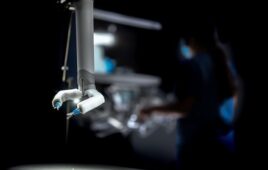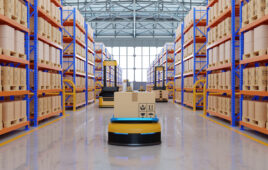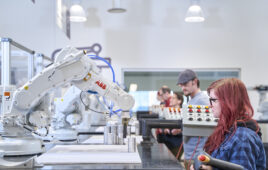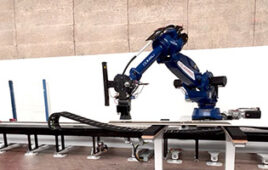I attended MD&M West a few weeks back and met with Epson who had a few unique and interesting design elements they integrate into their robots.
When Epson first started, they started with their SCARA robots, very fast, four-axis robots made for high speed and high precision. Group Product Manager of Epson, Rick Brookshire, noted how SCARA robots have some limitations when used for specific applications.
“So with SCARA, you’re moving something from flat to flat,” said Brookshire. “You pick up a washer, and the robot is placing it in another spot. But what if I need to pick up a bottle and turn it over upside down? That’s not flat to flat; there’s different planes.”
In turn, Epson expanded to six-axis robots that focused on enabling the bot to pick up different parts that didn’t consist of just moving something flat to flat. Instead, a six-axis bot could pick up a cellphone and place it in a box for assembly. Overall, Epson’s six-axis robots focus on high precision, high speed, and product assembly for parts that are really small.
Brookshire mentioned how the robots have the ability to place parts that go down to five microns in repeatability. For reference, a human hair is 100 to 200 microns.
“Five microns, you can’t see it,” said Brookshire. “For a device like a cell phone, you need to place a lot of components 15 to 20 microns, and it’s very critical we get that placement right every single time.”
What’s unique about Epson’s specific six-axis robot known as the N2, which is part of the N-series, is that it has the ability to fold-up underneath itself.
“Why is that important?” asked Brookshire. “Think of a six-axis robot’s arms. If humans were always walking with their elbows extended out, how well would we do walking through an aisle? We’d be banging into everything, and that’s basically what six-axis robots typically do. When they need to move, that elbow is constantly getting in the way.”
In turn, Epson created a six-axis robot that would be able to walk through aisles without bringing everything down with it.
“The N2 allows us to fold the elbow up underneath,” said Brookshire. “It folds up underneath itself so when it extends, it’s not the elbow first. It’s the arm first. We’ve been able to reduce the overall workspace acquired by 40 percent. That’s huge.”
Additionally, Brookshire showed off their T3 SCARA robot that was casually sorting through “diamonds” at their booth at MD&M West. The T3 SCARA is a slide-based solution that works with integrated vision and other Epson solutions.
What’s different about this bot, is they “hid” the controller within the T3 SCARA when developing it.
“The cool thing is the controller is built inside of the arm,” said Brookshire. “Usually there’s a robot, and then there’s a controller somewhere underneath. We made this, this way because it’s like saying, ‘Look Mom, there’s nothing up my sleeves.’ This is a cool design feature, and a lot of customers really like the fact that they don’t have to find a place for the controller.”
From folding arms to hidden controllers, Epson is looking forward to even more integration of different technologies such as utilizing AI features and vision.
“How do we figure out how to do faster cycles? How do we learn from what we’ve done and feed that back into the system? A lot of it is associated with vision,” said Brookshire. “We will continue to do more and more with AI.”
Brookshire also noted how AI has not taken huge strides since he was first introduced to the idea years ago.
“The difference between now and then is not unbelievable leaps and bounds,” said Brookshire. “It’s improved, but with AI, first you walk and then you run. You implement it in places that it can work really well, and you don’t have to depend on it to be perfect. That’s what we’re doing.”
For now, as Epson continues to make its mark on the robotic industry while using AI technology, we are likely to see some exciting new additions from Epson, perhaps even something this year.
Filed Under: Product design, Robotics • robotic grippers • end effectors




